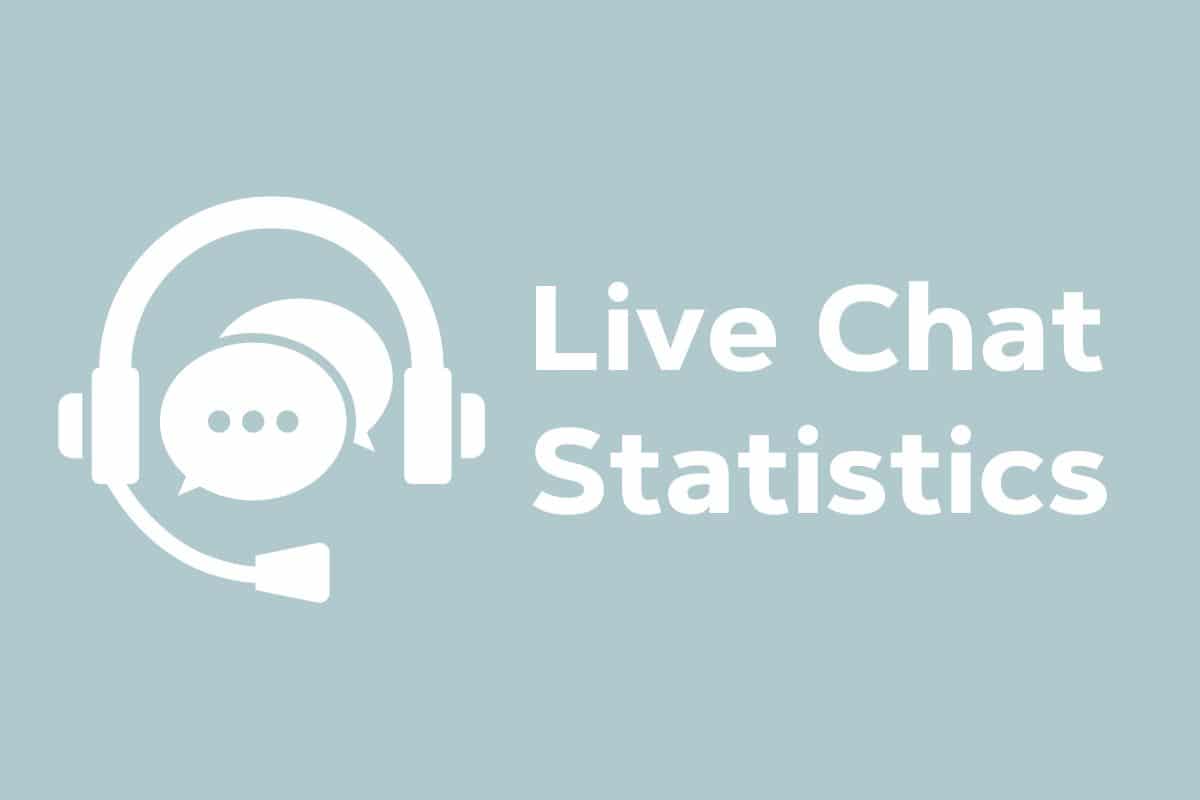Live Chat Statistics (Do Customers Prefer Live Chat?)
Welcome to our in-depth live chat statistics to see the power of real-time customer communication.
In the fast-paced customer engagement world, businesses constantly seek ways to optimize their interactions and enhance the customer experience.
Live chat can contribute to a tremendous boost in UX.
We explore the metrics that shape successful live chat strategies, from conversion rates and response times to customer satisfaction and sales growth.
Join us as we uncover the data-driven secrets behind effective live chat implementation, which can generate more passionate and loyal customers.
This post covers:
- Do Customers Prefer Live Chat?
- Live Chat Usage Statistics
- Desktop And Mobile Live Chat Statistics
- Chatbot Statistics
- Live Chat Conversion Statistics
- Live Chat Response Time Statistics
- Live Chat Customer Support Statistics
Live Chat Statistics (Our Top Picks)
- 41% of customers prefer live chat support
- Over 50% of consumers will stay loyal to a company with live chat support
- 87% of live chat conversations get a positive rating
- The live chat market size is expected to hit $1.6 billion by 2030
- 61% of B2B and 33% of B2C use live chat
- The live chat engagement is higher on desktop than on mobile
- User satisfaction increases to 92% when live chat is used on mobile
- Online shoppers who use live chat are 513% more likely to become customers
- Nearly 50% of US adults abandon their purchase if they don’t find quick answers
- 40% of consumers expect they won’t get the support quickly enough
- 53% of customers prefer to use online chat before calling the company for support
Do Customers Prefer Live Chat?
1. 41% of customers prefer live chat support
Of the four most common customer support channels, 41% of customers prefer to live chat with an agent. Telephone (32%), email (23%), and—interestingly—social media (3%) are second, third, and fourth.
Even though social media (have you seen our social media stats?) is growing in popularity, even when it comes to customer support, live chat is still preferred by MANY more consumers.
On the contrary, 42% of businesses think consumers prefer phone, 35% live chat, 14% email and 9% social media for support.
Source: Kayako
2. Over 50% of consumers will stay loyal to a company with live chat support
52% of consumers reported they will remain loyal to a live chat support company. Plus, nearly 40% of consumers are likelier to purchase from a company with live chat support. And of those who already purchased from a brand, 51% are more expected to buy again from the company with live chat support.
This shows that consumers want quick solutions without picking up the telephone, which is exactly what live chat offers.
Source: Kayako
3. 95% of consumers value quality over speed
Consumers even prefer live chat if it’s slow, but only if the quality they receive is higher (or higher than expected).
In the modern era, we live, we expect everything to be quick. However, 19 out of 20 consumers prefer slower support that’s personalized and quality.
Luckily, nearly 85% of businesses say offering a personal customer experience is “important” or “very important” to them. Unfortunately, many consumers say businesses fail to deliver the desired experience.
Source: Kayako
4. Nearly 70% of people shop more with retailers that offer consistent customer service
It’s not all about the quality of your products and services; it’s also about the quality and consistency of your customer service that will define your business success.
A whopping 69% of people say they shop more with retailers that offer consistent offline and online customer service. And live chat contributes to this consistency greatly.
See the importance of customer service by reviewing these essential customer service statistics.
Source: Forrester #1
5. 87% of live chat conversations get a positive rating
According to Tidio data, nearly 90% of live chat conversations get a positive customer satisfaction rating.
Remember, it’s not only the agent(s) that contribute to a better CSAT score; it’s also the business’s live chat software and the quality of the (personalized) chatbot.
Source: Tidio #1
Live Chat Usage Statistics
6. The live chat market size is expected to hit $1.6 billion by 2030
The live chat market was valued at $794 million in 2021 but is expected to grow at an 8.59% CAGR between 2022 and 2030. Meaning, it will grow to more than $1.6 billion by 2030.
The leading region in live chat software usage is North America, followed by Europe in second and Asia Pacific in third place.
Source: Verified Market Research
7. Tawk.to is the leading live chat technology worldwide
At a global share of 21%, Tawk.to is the most commonly used live chat technology, with Facebook Customer Chat Plugin close behind at 18%.
| Live chat technology | Share of users |
| Tawk.to | 21.41% |
| Facebook Customer Chat Plugin | 18.08% |
| Zendesk Chat | 8.46% |
| Tidio | 8.09% |
| LiveChat | 6.03% |
Source: Statista #1
8. 61% of B2B and 33% of B2C use live chat
Even though B2C businesses have a lot more customers and the demand for support is much higher, there are still many more B2B businesses that use live chat. The least common is live chat usage among B2G and non-profit organizations.
Source: Zoho
9. Younger people are using live chat more frequently
When it comes to using live chat by age, those aged between 18 and 34 used it “many times,” while those aged between 35 and 54 used it “a few times.” But the older generation, 55+, is more likely to have “never used” live chat.
Source: Software Advice
10. 15% of all visitors use the live chat
Tidio looked at nearly 300,000 websites over the course of a year that use their software and found that 15% of all websites’ visitors join live chat conversations.
Source: Tidio #1
Desktop And Mobile Live Chat Statistics
11. The live chat engagement is higher on desktop than on mobile
Even though the difference (0.3%) isn’t as huge as you’d expect, the live chat engagement is still higher on desktops (1.7%) than it is on mobiles (1.4%).
In addition to that, desktop chatters (14%) are also more likely to make a purchase than mobile (7%).
Source: Upscope
12. Mobile live chat users are 6.1x more likely to convert than non-chatters
When people join the live chat conversation, they already show an interest in the product or service. It was found that mobile chatters are 6.1x likelier to convert than those who don’t use the live chat function.
Source: Upscope
13. 60%+ of customers expect a live chat on mobile devices
A study by Moxie Software showed that 62% of online shoppers want to live chat with brands on mobile devices, thus expect the live chat to be available on mobile. And when they see a live chat widget, 82% of customers would use it.
Source: ICMI
14. User satisfaction increases to 92% when live chat is used on mobile
Moxie Software also found that 72% of consumers are “satisfied’ or “very satisfied” with customer support experience during their online shopping.
However, their satisfaction level increases to 92% when live chat is used – particularly on mobile devices.
You can learn more about CX by skimming through our in-depth customer experience statistics.
Source: ICMI
15. Only 7.6% of users chat on desktop devices
According to nearly one and a half billion chats (across thirty different industries and 32K companies), LiveChat found that, on average, only 7.6% of users use desktop devices for live chatting.
On the contrary, 92.4% of users use a live chat widget on their mobile devices.
Source: LiveChat
Chatbot Statistics
16. Chatbot market size is forecast to be $1.25 billion in 2025
The world of chatbots is expanding at a rapid pace. It was worth only $190 million in 2016 but is expected to jump to $1.25 billion by 2025.
Fun fact: The artificial intelligence software market is predicted to grow to $118.6 billion in 2025.
Source: Statista #2
17. There are nearly twice as many female chatbots than male
While chatbots aren’t human beings and are usually represented as genderless, still, the companies that use a chatbot persona typically opt for a woman avatar.
To be more precise, 37% of chatbots are female, almost twice as many as chatbots are represented as male.
Source: Statista #3
18. Live chats with chatbots receive a slightly higher satisfaction rate
If you want to improve the satisfaction rate of your live chat customer support/service, then you might want to implement a chatbot as the first interaction with the user.
But the difference between the satisfaction rate of live chats with chatbots and those that redirect to a live agent is less than 2%. (Just ensure you don’t make them wait for too long.)
Source: Comm100
19. Scripted, impersonal responses frustrate nearly 30% of consumers
Even though using chatbots and predetermined responses, the conversations still need to be as personal as possible – make users feel like individuals, not like numbers.
29% of consumers report that canned responses frustrate them. Surprisingly, 38% of businesses also say their users find canned responses frustrating.
Automation, AI and chatbots can benefit any business – but only when done right. Thus, you may want to check our marketing automation statistics to get more insights.
Source: Kayako
20. 74% of companies are satisfied with the integration of chatbots
Around three in four companies that integrated a chatbot are satisfied with it, while only 4% are unsatisfied. The rest are neutral about the integration.
Moreover, business owners who used chatbot templates out-of-the-box without modifying them are most satisfied, followed by those who created a chatbot from scratch.
Source: Tidio #2
Feel free to peek at these insightful chatbot statistics to learn more.
Live Chat Conversion Statistics
21. Online shoppers who use live chat are 513% more likely to become customers
Tidio reports that online shoppers who visit an eCommerce website and interact with a live chat are 513% more likely to turn into customers.
Note that the conversion rate boost due to the live chat can vary significantly by industry and niche and also the quality of the chatbot and agent.
Source: Tidio #1
22. 10% increase in average order value from customers who chat before making a purchase
Forrester found a 10% increase in average order value for customers who chat before making a purchase. Not just that, but they also discovered a nearly 50% increase in revenue per chat hour and a 40% conversion rate.
Source: ICMI
23. Digital shoppers who engage in a chat are worth 4.5 times more
Compared to digital shoppers who don’t engage with a live chat, those who do are worth 4.5 more. This is why the quality of the live chat is crucial – once they become “chatters,” you have a much higher chance of winning them over.
Source: ICMI
24. Nearly 80% of businesses with live chat reported better sales, revenue and customer loyalty
Integrating a live chat into your business has many benefits. 79% of companies say it positively impacts their sales, revenue and customer loyalty.
Source: Kayako
25. 63% of people who spend $250 and $500 monthly will likely buy from companies that offer live chat
People who spend anywhere up to $500 a month are most likely to purchase from and be loyal to companies that offer live chat.
Source: Kayako
26. Nearly 50% of US adults abandon their purchase if they don’t find quick answers
One of the biggest reasons US adult online shoppers abandon their purchases is that they cannot find quick answers to their “last minute” questions. This is where a live chat comes in handy, lowering the abandonment rates and increasing conversions – because of offering quick answers.
We also have an extensive shopping cart abandonment statistics roundup that will help you improve your business.
Source: Forester Opportunity Snapshot
27. 78% of customers forgive companies for their mistakes if they excel at customer service
When using a live chat, you must ensure that your customer service is of the best quality.
Why? Because even if you make a mistake (hey, everyone makes mistakes), customers will forgive you due to the amazing customer treatment you offer.
Note: 68% of customers expect brands to demonstrate empathy, and 66% expect them to understand their unique needs and expectations.
Source: Salesforce
28. Live chat helped Virgin Airlines improve conversions by 23%
Now let’s look at an actual example of how much a live chat contributes to a company’s conversions.
In the case of Virgin Airlines, after using a proactive live chat, they boosted conversion rates by 23%. Their customers who used live chat converted at almost 3.5 times the rate compared to those who didn’t.
Additionally, the order value of Virgin Airlines’ customers who used live chat was 15% higher.
Source: Digital Commerce 360
Live Chat Response Time Statistics
29. 24% of consumers’ biggest frustration is long wait times
If they’ll be in a queue, they’ll be frustrated – at least that’s something 24% of consumers say. And nearly 20% of businesses are aware of that, knowing that the wait times cause frustration.
And even though you learned before that consumers are willing to wait if the support quality is high – you’ll make them much happier if you reduce the wait time.
Source: Kayako
30. 40% of consumers expect they won’t get the support quickly enough
As soon as the consumers start a live chat conversation, 40% are already skeptical about receiving the necessary support in a reasonable amount of time. Surprise them with a fast and top-notch live chat experience they’ll remember forever.
Source: Kayako
31. 73% of customers value their time, making it the most important part of good customer service
We mentioned earlier that more than half of the customers abandon their online purchases if they don’t get quick answers.
Moreover, 73% of customers say that if the companies would value their time more, that would immediately improve the quality of their customer support (in the customers’ eyes).
Source: Forrester #2
32. The technology industry has the longer live chat wait time (82.2 seconds)
Even though the technology sector has the longest live chat wait times, it still improved by around six percent between 2020 and 2021.
The biggest improvement saw the travel industry, decreasing wait times from 50 seconds down to 19.9.
| Industry | Live chat wait time |
| Technology | 82.2 seconds |
| Telecommunications | 75.8 seconds |
| Education | 49.7 seconds |
| Government | 48.7 seconds |
| Transportation | 47.8 seconds |
| Non-profit | 40.5 seconds |
| Health, pharma and biotech | 38.7 seconds |
| Manufacturing | 38.2 seconds |
| Retail and eCommerce | 37.8 seconds |
| Banking and finance | 34.4 seconds |
| Business service | 29.1 seconds |
| Consumer products and services | 28.8 seconds |
| Real estate | 23.9 seconds |
| Entertainment | 23.5 seconds |
| Travel | 19.9 seconds |
Source: Statista #4
33. Companies with higher satisfaction ratings are more likely to have higher customer satisfaction ratings
Also, companies with customer satisfaction ratings above 90% have longer average live chat durations (11 minutes and 47 seconds) than those with below 90% ratings (8 minutes and 42 seconds).
Source: Comm100
Live Chat Customer Support Statistics
34. 21% of consumers see chatbots as the easiest way to contact a business
Over 20% of consumers say that when requesting customer support, the easiest way to reach a business is through chatbots. And if your customers require answers in less than half a minute, a chatbot is one of the best options.
Source: SAP
35. Online stores that lack live chat/real-time support are nearly 2x less trustworthy
A study by Tidio found that those online stores that don’t have a live chat and real-time support or lack quality end up being almost twice as less trustworthy as those that take live chat customer support seriously.
Source: Tidio #1
36. Live chat customer support has a positive influence on ROI
Businesses and companies that implement live chat customer support report better ROI than those that don’t. This is particularly true regarding proactive sales conversations through the live chat widget – many receive a 305% ROI.
Of course, the exact ROI depends on the industry, business size and even the quality of live conversations.
Source: The Ecommerce Expert
37. Businesses’ average chat support availability per day is 16 hours and 28 minutes
Even though the chat widget is available to customers 24/7, the agents are reachable, on average, 16 hours and 28 minutes per day. (LiveChat reports the average first response time per chat being 38 seconds.)
Source: LiveChat
38. 53% of customers prefer to use online chat before calling the company for support
The online chat became pretty engrained in us, as we prefer using it for customer support first thing (me and 53% of other customers included). Dialing in a company’s number comes second (and likely only if we don’t get the necessary support or additional details are required).
In addition, 71% of businesses believe that online chat (with or without a human agent) will surpass traditional customer support channels.
Source: ICMI, Bold360
39. More B2B and B2C businesses use live chat for sales than for customer support
Businesses saw the opportunity in live chat to increase their sales, so that’s where their main focus is.
According to Zoho, 85% of B2B and 74% of B2C businesses use live chat for sales. On the other hand, 67% of B2B and 66% of B2B businesses use it for customer support.
Source: Zoho
Conclusion
We leave you with a better understanding of the immense value and potential that the live chat holds for your thriving business in the digital space.
By adopting the insights from live chat data, your organization can make informed decisions, optimize its strategies and ultimately unlock greater success.
You can stay agile, enhance customer interactions, and achieve your growth goals by continuously monitoring live chat statistics and adapting to emerging trends.
If you don’t, your competition will, leaving you far behind in the world of ever-evolving customer engagement.
Integrate live chat into your business and revamp how you engage with your audience.








This Post Has 0 Comments